
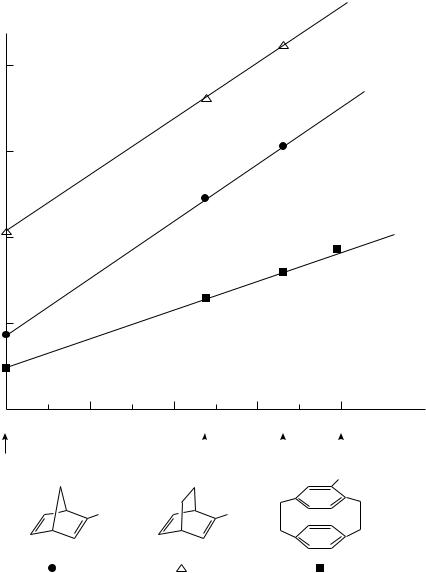
17. The electrochemistry of dienes and polyenes |
763 |
Oxidation Potential (V vs SCE)
2.2
2.0
1.8
1.6
1.4
0.2 |
0.4 |
0.6 |
0.8 |
|
|
σp+ |
|
|
|
|
|
|
|
|
|
|
|
|
|
X=H |
COOR |
CN |
NO2 |
|
|
|
X |
X |
|
X |
|
( ) |
( ) |
( |
) |
FIGURE 1. The relationship between the oxidation potential and pC
linear free energy correlations between the oxidation potentials which are required to remove an electron from the double bond not bearing the substituents and the pC parameter.
This result indicates that the substituent located on one bond affects electronically the process of electron removal from the other double bond which is not bearing the substituent.

764 Tatsuya Shono, Shigenori Kashimura and Naoki Kise
If the substituents are, however, electron-donating, the first electron transfer must take place at the double bond bearing the substituents. Hence, it is impossible to observe the transannular effect in this case.
Although it is unclear what type of value is the most suitable to use with a cation radical system, it is reasonable that the best linear relationship is given with C, although for the substituents investigated pC ³ p.
Despite the fact that the electrochemical oxidation of most of the nonconjugated dienes generally does not give products which result from interaction of the double bonds with one another, the anodic oxidation 1-acetoxy-1,6-heptadienes gives intramolecularly cyclized products, that is, the cyclohexenyl ketones (equation 15)13. The cyclization takes place through the electrophilic attack of the cation generated from enol ester moiety to
the double bond. |
|
|
|
|
|
|
|
|
|
|
|
|
|
|
|
|
|
|
|
|
|
|
|
|
|
|
|
|
|
|
|
|
|
||||||
|
|
OAc |
|
|
|
|
|
|
|
|
|
|
|
|
|
|
|
|
|
|
|
|
|
|
|
|
|
|
|
|
|
|
|
|
|
||||
|
|
|
|
|
|
|
|
|
|
|
|
|
|
|
|
|
|
|
|
|
|
|
|
|
|
|
|
|
|
|
|
|
|
|
|
|
|
|
|
R1C |
|
|
|
C |
|
|
|
|
(CH2 )3 |
|
|
|
CH |
|
|
|
CH2 |
|
|
|
|
||||||||||||||||||
|
|
|
|
|
|
|
|
|
|
|
|
|
|
|
|
|
|||||||||||||||||||||||
|
|
|
|
|
|
|
|
|
|
|
|||||||||||||||||||||||||||||
|
|
|
|
|
|
|
|
|
|
|
|
|
|
|
|
|
|||||||||||||||||||||||
|
|
|
|
|
|
|
|
|
|
|
|
|
|
|
|
|
|
|
|
|
|
|
|
|
|
|
|
|
|
|
|
|
|||||||
|
|
|
|
|
|
|
|
|
|
|
|
|
|
|
|
|
|
|
|
|
|
|
|
|
|
|
|
|
|
|
|
|
|
|
|
|
|
|
|
|
|
|
|
|
|
|
R2 |
|
|
|
|
|
|
|
|
|
|
|
|
|
|
|
|
|
|
|
|
|
|
|
|
|
|
|
|||||
|
|
|
|
|
|
|
|
|
|
|
|
|
|
|
|
|
|
|
|
|
|
|
|
|
|
|
|
|
|
|
|
|
|
|
|
|
|
||
|
|
|
|
|
|
|
|
|
|
|
|
|
A cOH, |
|
− e |
|
|
|
|
|
|
|
|
|
|
|
|
|
|
|
|||||||||
|
|
|
|
|
|
|
|
|
|
|
|
|
Et4 NOTs |
|
|
|
|
|
|
|
|
|
|
|
|
|
|
|
|
||||||||||
|
|
|
OAc |
|
|
|
|
|
|
|
|
|
|
|
|
|
|
|
|
|
|
|
|
O |
|
|
|
|
|||||||||||
|
|
|
|
|
|
|
|
|
|
|
|
|
|
|
|
|
|
|
|
||||||||||||||||||||
|
|
|
|
|
|
|
|
|
|
|
|
|
|
|
|
|
|
|
|
||||||||||||||||||||
|
|
|
|
|
|
|
|
|
|
|
|
|
|
|
|
|
|
|
|
|
|
|
R1C |
|
|
|
|
||||||||||||
|
|
+ |
|
|
|
|
|
|
|
|
|
|
|
|
|
|
|
|
|
|
|
|
|
|
|
|
|
|
|
|
|
|
|||||||
|
|
|
|
|
|
|
|
|
|
|
|
|
|
|
|
|
|
|
|
|
|
|
|
|
|
|
|
|
|
|
− e |
|
|
|
|
||||
|
|
R1C |
|
|
|
C |
|
|
|
(CH2 )3 |
|
|
|
|
CH |
|
|
|
|
CH2 |
|
+ |
|
|
|||||||||||||||
|
|
|
|
|
|
|
|
|
|
|
|
|
|
|
|
|
|
|
R2 |
|
|
||||||||||||||||||
|
|
|
|
|
|
|
|
|
|
|
|
|
|
|
|
|
|
|
|
|
|||||||||||||||||||
|
|
|
|
|
|
|
|
|
|
|
|
|
|
|
|
|
|
|
|
|
|
|
|
|
|||||||||||||||
|
|
|
|
|
|
|
|
|
|
|
|
|
|
|
|
|
|
|
|
|
|
|
|
|
|
|
|
|
|
|
|
|
|
|
|||||
|
|
|
|
|
|
|
|
|
R2 |
|
|
|
|
|
|
|
|
|
|
|
|
|
|
|
|
|
|
|
|
|
|
||||||||
|
|
|
|
|
|
|
|
|
|
|
|
|
|
|
|
|
|
|
|
|
|
|
|
|
|
|
|
|
|
|
|
|
|
|
|
||||
|
|
|
|
|
|
|
|
|
|
|
|
|
|
|
|
|
|
|
|
|
|
|
|
|
|
|
|
|
|
|
|
|
|
|
|
(15) |
|||
|
|
|
|
|
|
|
|
|
|
|
|
|
|
|
|
|
|
|
|
|
|
|
|
|
|
|
|
|
|
|
|
|
−H+ |
|
|
|
|
||
|
|
|
|
|
|
|
|
|
|
|
|
|
|
|
|
|
|
|
O |
|
|
|
|
|
|
|
|
|
O |
|
|
|
|
||||||
|
|
|
|
|
|
|
|
|
|
|
|
|
|
|
|
|
R1C |
|
|
|
|
|
|
|
|
R1C |
|
|
|
|
|||||||||
|
|
|
|
|
|
|
|
|
|
|
|
|
|
|
|
|
|
|
|
|
|
|
|
|
|
|
|
|
|
|
or |
|
|
|
|
||||
|
|
|
|
|
|
|
|
|
|
|
|
|
30~50% |
|
R2 |
|
|
|
|
|
|
|
|
R2 |
|
|
|
|
|||||||||||
|
|
|
|
|
|
|
|
|
|
|
|
|
+ |
|
R1C |
|
|
C |
|
|
CH |
|
(CH2 )2 |
|
CH |
|
CH2 |
||||||||||||
|
|
|
|
|
|
|
|
|
|
|
|
|
|
|
|
|
|
|
|
|
|
||||||||||||||||||
|
|
|
|
|
|
|
|
|
|
|
|
|
|
|
|
|
|
||||||||||||||||||||||
|
|
|
|
|
|
|
|
|
|
|
|
|
|
|
|
|
|
|
|
|
|
||||||||||||||||||
|
|
|
|
|
|
|
|
|
|
|
|
|
|
|
|
|
|
|
|
|
|
|
|
|
|
|
|
|
|
|
|
|
|
|
|
|
|
|
|
O R2
R1=Me, R2 =Me, Et
C. Trienes
The anodic oxidation of acyclic polyenes is practically useless, since the control of the reaction site is usually difficult and hence the product is often a mixture of isomers which are not always easily isolable.
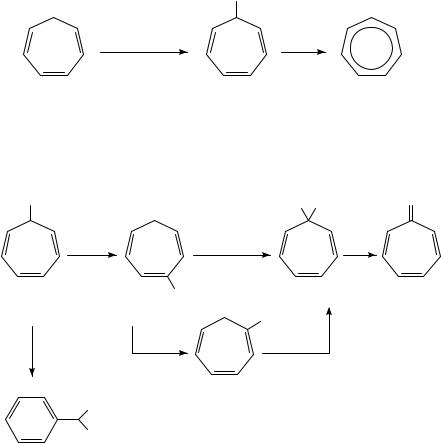
17. The electrochemistry of dienes and polyenes |
765 |
On the other hand, the anodic oxidation of 1,3,5-cycloheptatrienes is one of the most powerful key tools for the preparation of a variety of non-benzenoid aromatic compounds such as tropylium salts, tropones, tropolones, 2H-cyclohepta[b]furan-2-ones and azulenes14.
The anodic oxidation of 1,3,5-cycloheptatriene in MeOH, however, gives the product 7-methoxy-1,3,5-cycloheptatriene (7-MeO-CHT) in a rather low yield when the reaction is carried out by using Et4NOTs, NaOMe, Bu4NBF4 or H2SO4 as the supporting electrolyte. On the other hand, the use of a mixture of Et4NOTs and NaOMe as the supporting electrolyte dramatically increases the yield (equation 16).
OMe
− e |
HBF4 |
Et4 NOTs/NaOMe |
|
MeOH |
|
71%
+(16)
BF4 −
96%
The anodic oxidation of 7-MeO-CHT in MeOH results in the formation of benzaldehyde dimethyl acetal through a ring contracting rearrangement, whereas 3-MeO-CHT and 1-MeO-CHT are prepared by thermal rearrangement of 7-MeO-CHT and afford 7,7- diMeO-CHT in 83% and 85% yields, respectively, upon the anodic oxidation. The hydrolysis of 7,7-diMeO-CHT in 5% aqueous H2SO4 gives tropone in 85% yield (equation 17).
OMe |
|
OMe OMe |
O |
∆ |
|
− e |
H3 O+ |
150˚C, 1 h |
|
NaOMe/MeOH |
85% |
98% |
|
83% |
|
|
OMe |
|
|
|
|
OMe |
(17) |
− e Et4 NOTs/NaOMe |
∆ |
− e |
|
MeOH |
170˚C, 5h |
NaOMe/MeOH |
|
63% |
|
||
|
85% |
85% |
|
OMe
OMe
The transformation of 7,7-diMeO-CHT to ˛-, ˇ- and -tropolones is also achievable by using anodic oxidation in the key step (equation 18), namely the electrochemical oxidation of an isomeric mixture of diMeO-CHTs prepared by the thermal rearrangement of 7,7- diMeO-CHT yields a mixture of methyl ethers of ˇ- and -tropolones. On the other hand, the thermal rearrangement of the ethylene acetal of tropone gives 3,4-dioxyethylene-CHT as a single product due to the difficulty of formation of other isomers, and it yields the ether of ˛-tropolone upon anodic oxidation.

766 |
Tatsuya Shono, Shigenori Kashimura and Naoki Kise |
||||
MeO |
OMe |
|
O |
O |
|
|
|
|
|
∆ |
|
|
|
|
|
O |
O |
|
|
|
|
1. − e, MeOH |
2. H3 O+ |
|
|
|
|
62% |
|
|
|
|
|
|
|
|
∆ |
|
|
O |
(18) |
|
|
|
|
||
|
|
|
|
|
O |
|
|
|
|
|
OH |
|
|
|
|
O |
O |
|
|
|
1. − e, MeOH |
|
+ |
|
|
|
2. H3 O+ |
|
|
|
|
|
OMe |
|
|
MeO |
|
OMe |
53% |
|
|
|
|
|
|||
|
|
|
|
||
OMe
The anodic oxidation of 2-alkyl-3-MeO-CHT followed by hydrolysis of the intermediate 1-alkyl-7,7-diMeO-CHT gives 2-alkyltropones in high yields (equation 19). The precursor 2-alkyl-3-MeO-CHT is synthesized by the alkylation of 2-lithio-3-MeO-CHT prepared by the regioselective lithiation of 3-MeO-CHT with BuLi. The intermediate 1-alkyl-7,7- diMeO-CHT is highly useful for the synthesis of the azulene skeleton through its reaction with dimethyl acetylenedicarboxylate (equation 20).
n-BuLi, THF |
RX |
|
|
−78˚C |
|
|
|
Li |
R |
|
|
|
|
|
|
OMe |
OMe |
OMe |
|
|
|
||
|
MeOH |
− e |
(19) |
|
NaOMe |
|
|
O |
MeO |
OMe |
|
|
R |
R |
|
R = Me, 72% |
H3 O+ |
|
|
R = Allyl, 81% |
|
|
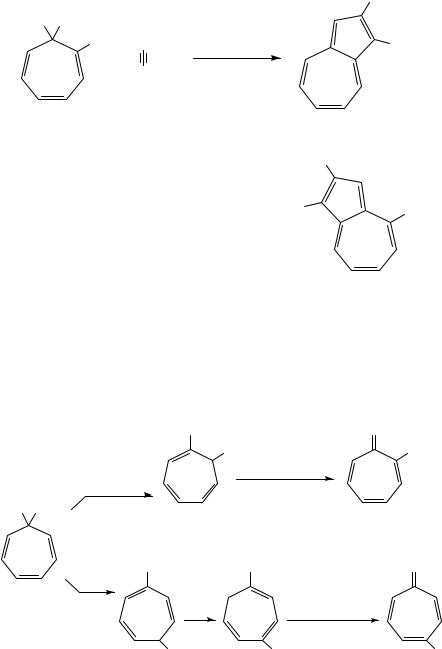
17. The electrochemistry of dienes and polyenes |
767 |
|
|
|
CO2 Me |
MeO OMe |
|
|
|
Me |
CO2 Me |
−2 MeOH |
CO2 Me |
|
|||
|
+ |
|
|
|
toluene, 1h reflux |
|
|
|
CO2 Me |
|
|
|
|
|
63%
(20)
MeO2 C
MeO2 C |
OMe |
+
10%
The electrochemical oxidation of 1-MeO-7-alkyl-CHT in MeOH yields 2-alkyltropones, while the thermal rearrangement of 3-MeO-7-alkyl-CHT to 1-MeO-4-alkyl-CHT followed by its anodic oxidation in MeOH affords 4-alkyltropones (equation 21). 1-MeO-7-alkyl- CHT is prepared by the regioselective alkylation of 7,7-diMeO-CHT with a Grignard reagent and CuI, while 3-MeO-7-alkyl-CHT is also regioselectively prepared by alkylation of 7,7-diMeO-CHT with an alkyl lithium.
|
OMe |
O |
|
R |
R |
|
|
1. − e, NaOMe/MeOH |
|
RMgX |
2. H3 O+ |
MeO OMe |
CuI (10 mol%) |
|
|
|
|
|
|
40~55% |
|
|
(21) |
OMe |
OMe |
O |
RLi |
|
|
|
∆ |
1. − e, NaOMe/MeOH |
|
|
2. H3 O+ |
R |
R |
R |
|
70~100% |
70~90% |
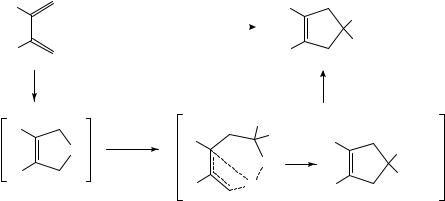
768 |
Tatsuya Shono, Shigenori Kashimura and Naoki Kise |
III. CATHODIC REDUCTION
A. Dienes
Compared with the anodic oxidation of a 1,3-diene, the cathodic reduction of a 1,3-diene may be less interesting since the resulting simple transformation to monoolefin and alkane is more conveniently achieved by a chemical method than by the electrochemical method. So far, only few reactions which are synthetically interesting have been studied15. The typical pattern of the reaction is the formation of an anion radical from 1,3-diene followed by its reaction with two molecules of electrophile as exemplified by the formation of the dicarboxylic acid from butadiene (equation 22)16.
|
|
|
|
|
|
|
+e |
HC |
|
|
|
|
|
|
|
|
CH2 |
D |
CH |
|
CH |
D |
CH2 |
! |
! |
HO2C CH2 |
|
CH |
D |
CH |
|
CH2CO2H |
22 |
|
|
|
|
|
|
|
CO |
|
|
|
|
|
|
|
|
|
|
|
|
|
|
|
|
|
|
|
|
50% |
|
|
|
||
On the other hand, it has been found that the electrochemical reduction is a very unique and useful tool in synthetic organic chemistry when magnesium is used as the material of the electrode. The cathodic reduction of 1,3-dienes with magnesium electrode gives very unique products, i.e. 3-cyclopentenol derivatives when it is carried out in the presence of a carboxylic acid ester (equation 23)17.
R1 |
|
R1 |
R3 |
|
+ R3 CO2 Me |
+e |
|
||
|
(23a) |
|||
LiClO4 /THF |
|
|||
|
|
OH |
||
R2 |
Mg cathode and anode |
R2 |
||
|
R1 |
|
R3 |
|
|
|
R1 |
|
OMe |
|
|
|
R3 CO2 Me |
|
R1 |
|
||
|
|
R3 |
|||
Mg |
|
O |
|
|
|
R2 |
|
|
|
|
|
R2 |
Mg |
|
|
OMgOMe |
|
|
|
R2 |
|||
|
|
|
(23b) This novel electroreductive cyclocoupling corresponds to a 1,4-addition of a one-carbon unit to the 1,3-diene, and does not take place without using magnesium electrode. The first step in this coupling reaction is the cathodic reduction of 1,3-diene to an anion radical, and the second step is the formation of a Mg-diene complex, which thereafter reacts with
the ester to yield the coupling product as shown in equation 23b.
The intermediary formation of the Mg-diene complex is confirmed by a two-step reaction method, namely in the first step a solution of 1,3-diene is electrochemically reduced with magnesium electrode in the absence of the ester. After a sufficient amount of electricity is passed, the current is terminated and the ester is added to the solution. The fact that the coupling product is also formed by this two-step method strongly supports the formation of the intermediate Mg-diene complex.
Some of the typical results are shown in Table 7. The aromatic ester does not give the cyclized product but other products were not identified.
This cyclocoupling reaction is not limited to acyclic dienes. Both 1-vinylcyclohexene and 1-vinylcycloheptene give the cyclized products in good yields (equation 24).
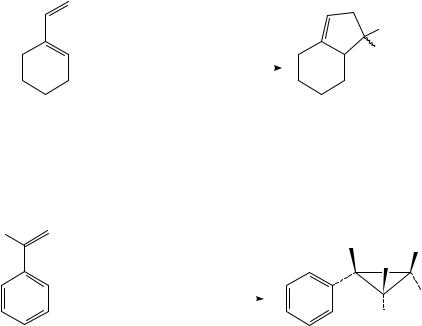
|
17. The electrochemistry of dienes and polyenes |
769 |
|||||||
|
TABLE 7. Cathodic coupling of 1,3-dienes with esters |
|
|
|
|||||
|
|
|
|
|
|
|
|
|
|
|
Diene |
|
|
Ester |
|
Product |
|
||
|
|
|
|
|
|
|
|
|
|
|
R1 |
R2 |
|
R3 |
|
Yield (%)a |
|
||
|
Me |
H |
|
n-Bu |
76 |
|
|||
|
Me |
H |
|
i-Pr |
71 |
|
|||
|
Me |
H |
|
PhCH2CH2 |
56 |
|
|||
|
(CH3)2CDCHCH2CH2 |
H |
|
Et |
63 |
|
|||
|
Me |
Me |
|
i-Pr |
88 |
|
|||
|
Me |
H |
|
Ph |
0 |
|
|||
|
|
|
|
|
|
|
|
|
|
|
a Isolated yields. |
|
|
|
|
|
|
|
|
|
|
|
|
|
|
|
|
|
Pr-i |
|
+ i-PrCO2 Me |
|
+e |
|
|
|
OH |
||
|
|
|
|
(24) |
|||||
|
LiClO4 /THF |
|
|
||||||
|
|
|
|
|
|||||
( )n |
Mg cathode and anode |
( )n |
|
||||||
|
|
|
|
|
|
||||
(n = 1) |
|
|
|
|
|
(n = 1) 62% |
|
||
(n = 2) |
|
|
|
|
|
(n = 2) 72% |
|
||
Although styrene is not a 1,3-diene, the cathodic reduction of a solution containing styrene and an ester with magnesium electrode interestingly affords a single stereoisomer of 2-phenylcyclopropanol derivative in which the phenyl and the alkyl (R2) groups are stereoselectively located in a cis relationship on the cyclopropane ring (equation 25).
R1
|
|
|
|
R1 |
OH |
|
|
|
|
|
H |
+ R2 CO2 Me |
+e |
|
|
|
R2 |
LiClO4 /THF |
|
|
|
||
|
|
|
|
H |
|
|
Mg cathode and anode |
|
|
|
|
|
|
|
|
|
(25) |
R1 = H |
Yield (%) |
|
|
|
|
R1 = Me |
R1 = H, R2 = Me |
71 |
|
|
|
|
R1 = H, R2 = Et |
67 |
cis |
|
|
|
R1 = H, R2 = i-Pr |
55 |
|
|
|
|
R1 = R2 = Me |
94 |
|
|
|
Although a 1,2-diene is not a conjugated diene, it is also electrochemically reducible with platinized platinum electrode in acidic solution to the monoolefin and a saturated alkane18.
In contrast with oxidation, clear reduction wave is not observed in the electrochemical reduction of cyclopentadiene19.
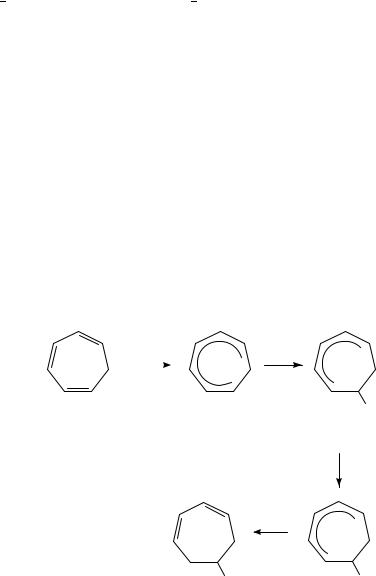
770 |
Tatsuya Shono, Shigenori Kashimura and Naoki Kise |
B. Trienes and Polyenes
The electrochemical reduction of cycloheptatriene (CHT) in liquid ammonia takes place at about 2.5 V vs SCE and forms the radical anion of CHT. The radical anion is stable in ammonia on the voltammetric time scale but decays slowly by disproportionation and coupling reaction pathways to give respectively 1,3- and 1,4-cycloheptadienes (total yield 34 39%) and C14H18 (in yields of 55 58%) isomers which incorporate the bitropyl carbon skeleta20.
The anionic intermediates generated by the cathodic reduction of CHT and some of its derivatives such as 1-MeO- and 3-MeO-CHTs are regioselectively alkylated with alkyl halides to give 6-alkyl-1,3-cycloheptadiene and 1-MeO-6-alkyl-1,3-cycloheptadiene as the main products, respectively21.
The electroreduction of CHT in DMF in the presence of n-butyl chloride gives, for example, 6-butyl-1,3-cycloheptadiene as the main product (equation 26). This selectivity in alkylation is interesting, since it is also known that the reductive butylation of CHT using Li/NH3 as the reducing agent gives a mixture of 5-butyl-1,3-cycloheptadiene and 3-butyl-1,4-cycloheptadiene in which the latter is the main product22,23.
This difference of regioselectivity in alkylation of CHT is explained by the difference of the electrophile which reacts with the first active intermediate formed from CHT. Thus, the first active intermediate formed by one-electron transfer to CHT is an anion radical species (A) in both the electrochemical and the Li-metal reduction.
Since the electroreduction is carried out in the presence of BuCl in aprotic solvent (DMF), A reacts with BuCl before it is protonated by the solvent to give a radical species
(B) as the second intermediate. It is reasonable that A reacts with BuCl at its 1- and 6-positions since the negative charge density is the highest at these two positions. In the third intermediate C, formed by one-electron reduction of B, the negative charge is mainly located at the 1-, 3- and 5-positions. The counter cation of the anion C is, however, the bulky Et4NC . Hence, anion C is most reactive at its 5-position and gives the 6-butyl derivative upon protonation at the 5-position21 (equation 26).
|
|
3 |
2 |
|
|
1 |
|
|
+e |
|
− |
|
|
4 |
• |
|
Et4 NOTs |
||
|
|
|
|
|
DMF |
|
|
|
|
5 |
6 |
CHT |
|
(A) |
|
2
3 1
4
5 6
Bu
BuCl •
Bu
(B)
+e (26)
3 1
H+
−
5
Bu
(C)

17. The electrochemistry of dienes and polyenes |
771 |
On the other hand, in the reduction of CHT with Li/NH3, butyl chloride is absent when A is formed and hence A is protonated by NH3 at its 1- and 6-positions to yield a radical intermediate D. In the anionic intermediate (E), formed by one-electron reduction of D, the negative charge is mostly located at the 1-, 3- and 5-positions. Hence, the butylation takes place at these positions to give 5-butyl-1,3-cycloheptadiene and 3-butyl- 1,4-cycloheptadiene as the final products (equation 27).
|
+e |
H+ from |
|
|
|
CHT |
NH3 |
• |
|
|
|
A |
|
|
|
||
|
Li/NH3 |
|
|
|
|
|
|
|
H |
|
|
|
|
|
(D) |
|
|
|
|
Li/NH3 +e |
|
4 |
Bu |
|
|
|
3 |
5 |
|
|
|
|
|
(27) |
|
|
|
|
|
|
|
|
|
|
2 |
|
|
|
3 |
5 |
|
1 |
|
|
|
|
|
|
|
|
− |
1. BuCl |
|
H |
|
|
|
|
|
||
|
|
2. H+ |
Bu |
4 |
|
|
1 |
H |
3 |
|
|
|
|
|
|
|
2
(E)
1
H
TABLE 8. Reduction peak potentials for some derivatives of cyclooctatetraene
Ep (V vs SCE)
−1.62
)2
−1.66
(CH2 )n
n = 1 |
−1.62 |
n = 2 |
−1.66 |
n = 3 |
−1.68 |

772 |
Tatsuya Shono, Shigenori Kashimura and Naoki Kise |
This electroreductive alkylation is successfully applied to the synthesis of ˇ-thujaplicin. Cyclooctatetraene and some of its derivatives are electrochemically reducible in dry degassed DMF containing Bu4NClO4 as the supporting electrolyte. The first reduction peak potentials which are required to form the corresponding anion radical are shown in
Table 824, though a further reaction of the intermediates is not known.
The electrochemical reduction of azulene with carbon, platinum, lead or zinc cathode does not give any product, whereas that with magnesium electrode yields a dimeric compound as the only reduction product, though the dimeric compound is easily transformed to the corresponding monomeric compound by a mild oxidation as shown in equation 2825.
2 −
+e, Mg electrode THF, LiClO4
MeI
Me
HCO2 Me
Me
~100%
(28)
Pd/C |
OHC |
~100% |
CHO |
Me
CHO
Although benzene is not a triene and its electrochemical reduction is not always practically facile, the benzenoid ring has been found to be easily reduced by the electrochemical method when magnesium is used as cathode26 (equation 29). As some of the typical
